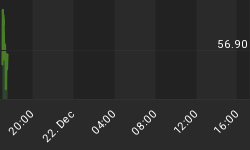I hadn't meant to do a 'part 2' on the dollar, but I wanted to clear something up.
Some comments on yesterday's article have suggested that a strong dollar is a global deflationary event, and vice-versa. But this is incorrect.
The global level of prices is determined by the amount of money, globally, compared to global GDP. But the movements of currencies will determine how that inflation or deflation is divvied up. Let us look at a simplified (economist-style) example; I apologize in advance to those who get college flashbacks when reading this.
Consider a world in which there are two countries of interest: country "Responsible" (R), and country "Irresponsible" (I). They have different currencies, r in country R and i in country I (the currencies will be boldface, lowercase).
Country R and I both produce widgets, which retail in country R for 10 r and in country I for 10 i. Suppose that R and I both produce 10 widgets per year, and that represents the total global supply of widgets. In this first year, the money supply is 1000r, and 1000i. The exchange rate is 1:1 of r for i.
In year two, country I decides to address its serious debt issues by printing lots of i. That country triples its money supply. FX traders respond by weakening the i currency so that the exchange rate is now 1:2 of r to i.
What happens to the price of widgets? Well, consumers in country R are still willing to pay 10 r. But consumers in country I find they have (on average) three times as much money in their wallets, so they would be willing to pay 30 i for a widget (or, equivalently, 15 r). Widget manufacturers in country R find they can raise their prices from 10 r, while widget manufacturers in country I find they need to lower their price from 30 i in order to be competitive with widget manufacturers in R. Perhaps the price in R ends up at 26r, and 13i in I (and notice that at this price, it doesn't matter if you buy a widget in country R, or exchange your currency at 1:2 and buy the widget in country I).
Now, what has happened to prices? The increase in global money supply - in this case, caused exclusively by country I - has caused the price of widgets everywhere to rise. Prices are up 30% in country R, and by 160% in country I. But this division is entirely due to the fact that the currency exchange rate did not fully reflect the increased money supply in country I. If it had, then the exchange rate would have gone to 1:3, and prices would have gone up 0% in country R and 200% in country I. If the exchange rate had overreacted, and gone to 1:4, then the price of a widget in country R would have likely fallen while it would have risen even further in country I.
No matter how you slice it, though - no matter how extreme or how placid the currency movements are, the total amount of currency exchanged for widgets went up (that is, there was inflation in the price of widgets in terms of the average global price paid - or if you like, the average price in some third, independent currency). Depending on the exchange rate fluctuations, country R might see deflation, stable prices, or inflation; technically, that is also true of country I although it is far more likely that, since there is a lot more i in circulation, country I saw inflation. But overall, the "global" price of a widget has risen. More money means higher prices. Period.
In short, currency movements don't determine the size of the cake. They merely cut the cake.
In a fully efficient market, the currency movement would fully offset the relative scarcity or plenty of a currency, so that only domestic monetary policy would matter to domestic prices. In practice, currency markets do a pretty decent job but they don't exactly discount the relative changes in currency supplies. But as a first approximation, MV≡PQ in one's own home currency is not a bad way to understand the movements in prices.
You can follow me @inflation_guy!
Enduring Investments is a registered investment adviser that specializes in solving inflation-related problems. Fill out the contact form at http://www.EnduringInvestments.com/contact and we will send you our latest Quarterly Inflation Outlook. And if you make sure to put your physical mailing address in the "comment" section of the contact form, we will also send you a copy of Michael Ashton's book "Maestro, My Ass!"















